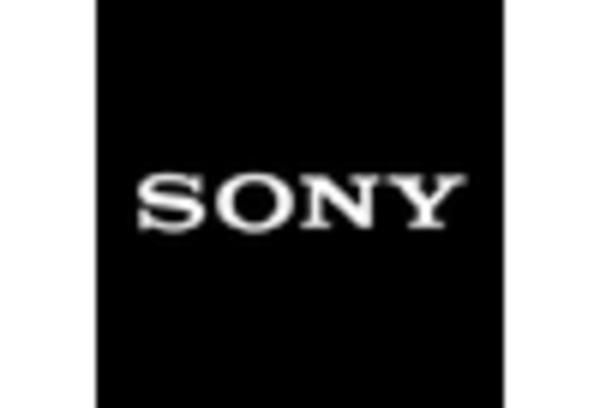Growing Adoption of Smart Devices
The increasing proliferation of smart devices, such as smartphones, tablets, and smart TVs, is a primary driver of the Wireless Display Market. As consumers and businesses alike embrace these technologies, the demand for wireless display solutions rises. In 2025, it is estimated that the number of smart devices in use will surpass 30 billion, creating a substantial market for wireless display technologies. This trend indicates a shift towards more integrated and user-friendly experiences, where seamless connectivity is paramount. The Wireless Display Market is likely to benefit from this growing ecosystem, as manufacturers innovate to provide solutions that cater to the needs of tech-savvy consumers and enterprises.
Advancements in Wireless Technologies
Technological advancements in wireless communication protocols, such as Wi-Fi 6 and Bluetooth 5.0, are propelling the Wireless Display Market forward. These innovations enable faster data transfer rates, improved connectivity, and reduced latency, enhancing the overall user experience. As these technologies become more widespread, the adoption of wireless display solutions is expected to increase. In 2025, the market for wireless communication technologies is anticipated to grow significantly, further driving the demand for wireless display products. This trend indicates that manufacturers must continue to innovate and adapt to the evolving technological landscape to remain competitive.
Surge in Remote Work and Collaboration Tools
The rise of remote work has catalyzed the demand for effective collaboration tools, significantly impacting the Wireless Display Market. As organizations adapt to hybrid work models, the need for wireless display solutions that facilitate virtual meetings and presentations has become increasingly apparent. In 2025, it is projected that the market for collaboration tools will reach approximately 20 billion USD, with wireless display technologies playing a crucial role in enhancing communication. This shift not only underscores the importance of wireless displays in professional settings but also suggests a long-term trend towards more flexible and efficient work environments.
Rising Consumer Preference for Wireless Solutions
Consumer preferences are shifting towards wireless solutions, which is a significant driver for the Wireless Display Market. The convenience of eliminating cables and the flexibility of wireless displays appeal to both consumers and businesses. In 2025, it is estimated that over 60% of consumers will prefer wireless display options for their home entertainment systems and office setups. This trend suggests that manufacturers must prioritize the development of user-friendly, reliable wireless display technologies to meet the growing demand. As consumer awareness of the benefits of wireless solutions increases, the market is likely to expand further.
Integration of Artificial Intelligence and Machine Learning
The integration of artificial intelligence (AI) and machine learning (ML) into wireless display technologies is emerging as a key driver in the Wireless Display Market. These technologies enable smarter, more adaptive display solutions that can learn user preferences and optimize performance accordingly. In 2025, the market for AI-driven technologies is projected to reach 190 billion USD, indicating a robust interest in intelligent solutions. This integration not only enhances user experience but also opens new avenues for innovation in wireless displays. As AI and ML continue to evolve, their impact on the Wireless Display Market is expected to grow, potentially transforming how users interact with their devices.
















Leave a Comment